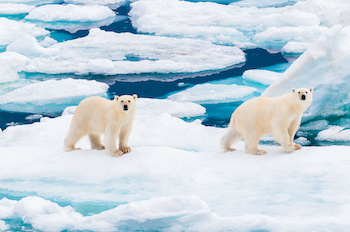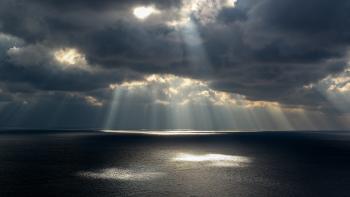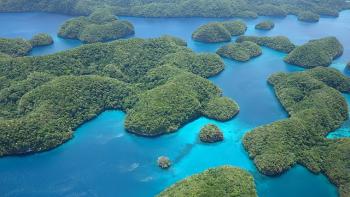Brief summary
The Centre for Climate Repair at the University of Cambridge seeks to reduce emissions of greenhouse gases (GHGs), to remove excess GHGs from the atmosphere, and to refreeze the Arctic. Mathematics plays a vital role in these efforts.
The Centre for Climate Repair (CCR) has recently become our neighbour here at the Centre for Mathematical Sciences at the University of Cambridge. But what is climate repair? And what does it have to do with maths? We talked to the Centre's Director of Research, Shaun Fitzgerald, to find out, and to learn about his contribution to the recent COP28 summit.
Reduce, remove, refreeze
The Centre for Climate Repair (CCR) has a three-fold mission: to reduce emissions of greenhouse gases (GHGs), to remove excess GHGs from the atmosphere, and to refreeze the Arctic.
"The fundamental problem is that GHG levels are too high, therefore temperatures are too high, and the rate at which they are rising is out of control," says Fitzgerald. "Our mission is to get GHG levels down, but also provide options for society so we don't lose precious ecosystems, we don't lose the ice on Greenland or Antarctica, and see devastation world wide. That's why we have to do these three things"
The CCR is multidisciplinary and multi-institutional. "Any particular approach we are exploring involves the social sciences, the physical sciences, mathematics, and engineering," says Fitzgerald. "It also involves people from the Judge Business School, for example, looking at financing and others looking at carbon credits in the GHG removal space." The CCR comprises members of several departments at the University of Cambridge, including the Department of Applied Mathematics and Theoretical Physics (DAMTP), Engineering, Geography, Land Economy, and Architecture. It also works in affiliation with Cambridge Zero.
Thickening the ice
We're all familiar with the idea that GHG emissions need to be reduced, and most of us will have heard of efforts to remove them from the atmosphere, for example by planting trees. The refreeze aspect of the Centre's mission is probably the most surprising. "Refreeze means looking at other options for protecting the Earth, for example by reflecting more of the Sun's radiation away from the Earth before it has a chance to heat the Earth," says Fitzgerald. "This is sometimes called geoengineering, but we call it refreeze."
 Ice plays an important role in reflecting the Sun's radiation back into space.
Ice plays an important role in reflecting the Sun's radiation back into space.
CCR is working on a number of projects under the banner of the Refreeze mission. One of them, led by Fitzgerald and supported by Grae Worster, Professor of Fluid Mechanics at DAMTP, aims to grow more Arctic sea ice over the Arctic winter so that it can last longer over the Arctic summer, maintaining a greater extent of ice. "This is pretty important because ice is reflective and the dark ocean is not," says Fitzgerald.
One way of potentially achieving the thickening is to pump sea water on top of ice that has already formed. Here the sea water is free to radiate heat into the atmosphere and therefore freeze more easily than it does under the ice.
"The idea is to explore whether it's possible to pump enough sea water on top of sea ice and therefore increase the rate at which the sea ice forms," explains Fitzgerald. "We are working with scientists here at DAMTP who are experts in fluid mechanics and understand heat and mass transfer, and who also understand the phase transition between sea water and sea ice. There's a body of knowledge here, with Professor Grae Worster, that is unparalleled. We are also working with an entity called Real Ice, a not-for-profit company who have already been doing field trials and public engagement in the Arctic, and with Arctic Reflections who are also supporting this overall initiative."
Preserving glaciers
The most imposing examples of polar ice are glaciers — the doomsday glacier in Antarctica, for example, is only a little smaller in area than Great Britain with the thickness of the ice reaching up to 1200m.
"Glaciers are really important when it comes to sea level rise," says Fitzgerald. "If we lose the glaciers on Greenland, that's 6 metres of sea level rise, and if we lose the glaciers on Antarctica that's many tens of metres of sea level rise. This is where maths comes in, as well as experimentation and, later, field trials. Mathematical modelling can help us understand how we can reduce the rate of ingress of warm saline water at the base of a glacier that is entering the ocean. Can we put a flexible barrier up?"
"Another project going on here at DAMTP, with Professor Jerome Neufeld, is trying to understand the flow of the glacier towards the sea and whether you might be able to intervene and reduce the rate of slippage of the glacier." There are ideas of how this can be done, for example by pumping melt water, which acts as a lubricant, away from the glacier. "Jerome is interested in, first and foremost, trying to understand the way a glacier slips down the bedrock as a function, for example, of melt rate. That alone is a very hard problem." Results so far suggest that, instead of pumping melt water away, it might be better to induce the formation of channels for the water to run through. "This is a wonderful example of how mathematical modelling can really help our understanding."
Geoengineering: Friend or foe?
The idea of geoengineering, large-scale interventions in natural processes to counteract climate change, has drawn some criticism. There are fears of unexpected consequences, and worries that remedies to climate damage will deflect attention away from addressing the root causes of climate change.
Fitzgerald prefers the term "climate engineering" and calls for an open mind. "I am not suggesting that all the proposed solutions are necessarily good things. I am saying that we need to do more research to understand with greater clarity what the benefits are and what the cons are, and what would be involved if ever we would scale them up. And we need to do all this at pace so that society has options it can then consider."
Fitzgerald points out that we have inadvertently performed some geoengineering for some time. One approach that has been associated with geoengineering is the injection of particles, such as sulphur dioxide, into the stratosphere. This would create droplets of sulphuric acid which would reflect some of the Sun's radiation back out to space. It's a process that happens in large volcanic eruptions.
 Marine cloud brightening involves making the clouds over the oceans optically brighter, so that they reflect sunlight away from the Earth.
Marine cloud brightening involves making the clouds over the oceans optically brighter, so that they reflect sunlight away from the Earth.
The emissions of ships traversing the oceans have also contained sulphur, but recently new regulations on shipping fuel have been introduced to make those emissions cleaner. This has health benefits for people near the coast. "But when the ships are way out in the middle of the ocean, the emissions don't make it onto the land as easily," says Fitzgerald. "And yet, that fuel mixture has been helping to reflect some of the Sun's radiation back out to space. So as a result of the change in the shipping regulations we now see the Earth a bit warmer than it was before, according to some recent research."
The question is whether the regulations should be reversed, not near land, but out in the ocean. "These are valid questions that have been posed, not just by me, but also by the founders of Extinction Rebellion."
The emissions of ships are also related to another project pursued by CCR: marine cloud brightening. The idea is to get the clouds that form over the ocean to be comprised of more smaller droplets rather than fewer larger ones. This would make them optically brighter, so they would reflect more sunlight. Research into the idea involves the mathematics of droplet formation and also atmospheric modelling, as pursued by Peter Haynes, Professor of Applied Mathematics at DAMTP.
If ships are to play a role in changing the make-up of clouds through their emissions, then even artificial intelligence, in the form of machine learning, will enter the picture, because sophisticated algorithms will be needed to work out optimal shipping routes. "Shipping is already causing marine clouds to form and for them to be brighter," says Fitzgerald. "So even without any technology, might we consider the existing flotilla and use machine learning to see what you might do with the existing infrastructure?"
These examples highlight the need for a holistic debate so that unintended consequences in all directions can be captured.
COP28
Fitzgerald took part in the climate summit COP28, which took place in Dubai in late 2023. He contributed to science discussions as part of the so-called blue zone, the formal conference and negotiation space. "Participants had divergent views, but discussions were robust and constructive." he says.
As far as climate engineering is concerned, Fitzgerald was impressed by the UN Ambassador for the islands of Palau, Illana Seid. "The ambassador said that the idea of sea level rise of one or two metres for her people is not losing a bit of beach. It's losing their country." Her message, says Fitzgerald, is that climate engineering options — such as sea bed curtains, ice thickening, or solar radiation management — should be researched with urgency. "These minority voices need to be amplified because they need a big seat at the table."
 An aerial view of the Rock Islands of Palau. Sea level rise would be disastrous here. Photo: Luka Peternel, CC BY-SA 4.0 DEED.
An aerial view of the Rock Islands of Palau. Sea level rise would be disastrous here. Photo: Luka Peternel, CC BY-SA 4.0 DEED.
COP28 has generally not been viewed as a roaring success, but Fitzgerald points to the positives. "It's amazing that in an oil state hosting the COP, for the first time it was agreed by all parties in writing that we must transition away from fossil fuels," he says. "It's taken 28 COPs, so nearly 30 years, to state the obvious, so that's the flip side. But let's give progress recognition for what it is."
Alongside the blue zone, COP28 also featured a green zone, which provides a space for the public to discuss, present, and exchange solutions to the climate crisis. This form of public involvement, says Fitzgerald, is paramount. "It's very important we have open discussions, where we're not judging if something is a good thing or a bad thing," he says. "Sharing the openness of mind and the hazards associated with climate engineering is crucial."
The worries that climate engineering solutions might stop people trying to curb GHG emissions are akin to worries in other fields, such as medicine: if you offer people an effective weight loss drug, will they stop eating well? Fitzgerald says there's a lot to learn from other disciplines, but also that we're not yet at the corresponding stage. "At the moment we're not offering the climate engineering drug to the world. We just want to know more about these things. This might show that some of the proposed solutions are actually nuts — that the hazards associated with them might well be rather greater than the benefits originally proposed. And conversely, it may indicate which ones might offer benefits which are greater than the modelled downsides, which society may therefore seek to consider."
Further research is the only way to find out. Mathematicians play a vital role in the effort, so that society can make more informed decisions as to whether these ideas could play a role in the journey to a 1.5 degrees Celsius world.
About this article
Shaun Fitzgerald OBE is Director of Research at the Centre for Climate Repair. He talked to Marianne Freiberger, Editor of Plus, in January 2024.